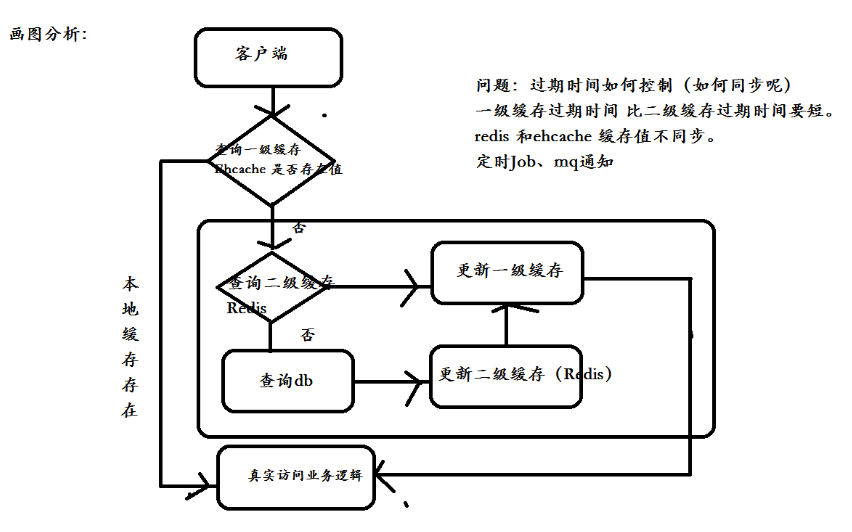EhCache
Ehcache是一个标准的开源缓存,可提高性能,减轻数据库负载并简化可伸缩性。因为它健壮,可靠,功能齐全并可以与其他流行的库和框架集成,所以是最广泛使用的基于Java的缓存。Ehcache可以从进程内缓存扩展到具有TB级缓存的混合进程内/进程外部署
基本架构
Ehcache是用来管理缓存的一个工具,其缓存的数据可以是存放在内存里面的,也可以是存放在硬盘上的。
其核心是CacheManager,一切Ehcache的应用都是从CacheManager开始的。它是用来管理Cache(缓存)的,一个应用可以有多个CacheManager,而一个CacheManager下又可以有多个Cache。
Cache内部保存的是一个个的Element,而一个Element中保存的是一个key和value的配对,相当于Map里面的一个Entry
缓存过期策略
当缓存需要被清理时(比如空间占用已经接近临界值了),需要使用某种淘汰算法来决定清理掉哪些数据
- FIFO:First In First Out,先进先出。判断被存储的时间,离目前最远的数据优先被淘汰。
- LRU:Least Recently Used,最近最少使用。判断最近被使用的时间,目前最远的数据优先被淘汰。
- LFU:Least Frequently Used,最不经常使用。在一段时间内,数据被使用次数最少的,优先被淘汰。
Spring Boot整合EhCache
- 引入依赖
<dependency> <groupId>org.springframework.boot</groupId> <artifactId>spring-boot-starter-cache</artifactId></dependency><dependency> <groupId>net.sf.ehcache</groupId> <artifactId>ehcache</artifactId> <version>2.10.6</version></dependency>- 配置
spring: cache: type: ehcache # 配置缓存类型 ehcache: config: classpath:ehcache.xml # ehcache的配置文件- 编写ehcache配置文件
<?xml version="1.0" encoding="UTF-8"?><ehcache xmlns:xsi="http://www.w3.org/2001/XMLSchema-instance" xsi:noNamespaceSchemaLocation="http://ehcache.org/ehcache.xsd"> <!-- 默认缓存 --> <defaultCache maxElementsInMemory="1000" eternal="true" timeToIdleSeconds="120" timeToLiveSeconds="120" overflowToDisk="true" diskSpoolBufferSizeMB="30" maxElementsOnDisk="10000000" diskPersistent="true" diskExpiryThreadIntervalSeconds="120" memoryStoreEvictionPolicy="LRU"> </defaultCache> <!-- userCache详细配置 --> <cache name="userCache" maxElementsInMemory="1000" eternal="false" timeToIdleSeconds="120" timeToLiveSeconds="120" overflowToDisk="true" diskSpoolBufferSizeMB="30" maxElementsOnDisk="10000000" diskPersistent="false" diskExpiryThreadIntervalSeconds="120" memoryStoreEvictionPolicy="LRU"> </cache> <!-- 一、以下属性是必须的: 1、name: Cache的名称,必须是唯一的(ehcache会把这个cache放到HashMap里)。 2、maxElementsInMemory:在内存中缓存的element的最大数目。 3、maxElementsOnDisk:在磁盘上缓存的element的最大数目,默认值为0,表示不限制。 4、eternal:设定缓存的elements是否永远不过期。如果为true,则缓存的数据始终有效,如果为false那么还要根据timeToIdleSeconds,timeToLiveSeconds判断。 5、overflowToDisk: 如果内存中数据超过内存限制,是否要缓存到磁盘上。 二、以下属性是可选的: 1、timeToIdleSeconds: 对象空闲时间,指对象在多长时间没有被访问就会失效。只对eternal为false的有效。默认值0,表示一直可以访问。 2、timeToLiveSeconds: 对象存活时间,指对象从创建到失效所需要的时间。只对eternal为false的有效。默认值0,表示一直可以访问。 3、diskPersistent: 是否在磁盘上持久化。指重启jvm后,数据是否有效。默认为false。 4、diskExpiryThreadIntervalSeconds: 对象检测线程运行时间间隔。标识对象状态的线程多长时间运行一次。 5、diskSpoolBufferSizeMB: DiskStore使用的磁盘大小,默认值30MB。每个cache使用各自的DiskStore。 6、memoryStoreEvictionPolicy: 如果内存中数据超过内存限制,向磁盘缓存时的策略。默认值LRU,可选FIFO、LFU。 --></ehcache>- 缓存注解配置
@CacheConfig(cacheNames ={"userCache"}) // 设置缓存的标志@Servicepublic class UserService { // 这个方法的返回值会被缓存 @Cacheable public String username(){ return UUID.randomUUID().toString(); } // 这个方法会清除缓存 @CacheEvict public void update(){ }}- 开启缓存
@SpringBootApplication@EnableCachingpublic class EhcacheApplication { public static void main(String[] args) { SpringApplication.run(EhcacheApplication.class, args); }}Redis+EhCache分布式缓存架构

这里要注意的是以及缓存的过期时间要比二级缓存早
同时,由于查询redis要走网络,所以可以把ehcahe作为一级缓存,redis作为二级缓存